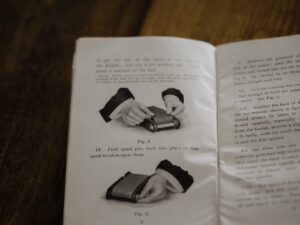
Repair and maintenance information is often crucial for the repair of today’s increasingly complex and computerised products and devices. Copyright’s subsistence in repair manuals and information can run contrary to the public interest in access and dissemination of this information, leading to the premature product obsolescence and abandonment.
The InfoSoc Directive’s non-mandatory exception for the “uses in connection with the repair or demonstration of equipment” suggests an avenue for enabling wider access to repair information. This could benefit participatory repair activities such as tool libraries and repair cafes across Europe. In this blog post, based on a recently published article, I assess this lesser-explored exception and call for its wider implementation and expansive interpretation by EU member states.
Every one of us can probably recite a frustrating Right to Repair story: A broken smartphone screen that is more costly to replace than to buy a shiny new device. A leaky door seal on a washing machine for which the manufacturer no longer provides a replacement. A printer with an inaccessible faulty €0.50 capacitor which prevents it from powering on. Even where replacement parts or tools are readily available, the necessary expertise and know-how can be hard to find. And so, with reluctance, we throw these things away and make our obligatory contributions to a massive pile of electronics waste, the fastest growing stream of solid waste globally.
The Right to Repair is a public interest movement which seeks to find a way out of this frustrating trajectory. The movement calls for greater access to parts, tools, software, and information necessary to complete repairs of various products and devices. By opening the ability to conduct repairs to everyday people, it seeks to extend product lifespan, reduce waste, encourage market competition, increase consumer choice, and facilitate innovative processes. Repair also offers important social benefits by bolstering technological literacy, empowering users of various technologies to become aware of their inner workings, and to enable people to exercise self-reliance and autonomy.
Repair information is a crucial resource for carrying out repairs safely and reliably. Often comprised of published works, this broad category can include instruction manuals, guides, tutorials, parts lists, wiring diagrams, and diagnostic information. It is often prepared and published by either the original equipment manufacturers (OEMs) or third-party publishers. And even though these works are often primarily utilitarian facts, ideas, and procedures, most are sufficiently original to attract copyright originality in their entirety. This has allowed manufacturers and rightsholders to curtail their unauthorised reproduction and communication online.

The conflict between repair information exclusivity and the public interest came to a head in 2020 when iFixit, an online source for repair resources, published its medical device library in response to the COVID-19 crisis. The medical device repair library includes repair information for various medical devices, including imaging devices, ventilators, and laboratory equipment. At least one medical device manufacturer took issue with the online library and sent iFixit a cease-and-desist letter, citing its exclusive rights under copyright to reproduce and communicate the repair information online. Citing the U.S. doctrine of fair use, iFixit and the Electronic Frontier Foundation (EFF) refused to take down the manuals and have since stood by their stance.
But without the ability for similar repair resources in Europe to avail themselves of the fair use doctrine, there are comparatively fewer grounds in the EU for refusing to take down repair and maintenance information should an analogous scenario arise. The EcoDesign Directive’s 2019 Implementing Regulations obligate manufacturers of certain products to provide access to repair information, but these obligations are limited to professional repairers and they permit manufacturers to charge fees and create other restrictions in providing access. For non-commercial and community repair activities like repair cafés, the EcoDesign obligations are of little help. There is, however, a glimmer of hope for non-commercial and independent repairers left by an optional exception in the InfoSoc Directive: Article 5(3)(l) permits “uses in connection with the repair or demonstration of equipment” (the “Repair Exception”).
The Repair Exception has never been interpreted by the CJEU and seldom has it received much academic analysis or commentary. Nevertheless, quite a lot can be gleaned from its genesis and member state implementation. The historical context of the Repair Exception appears to be rooted in repair shops which would display and demonstrate the functioning of various equipment which would incidentally perform or display copyright works. And while the legislative inspiration for the Repair Exception is not entirely clear, all signs point to §56 of Germany’s Act on Copyright and Related Rights (UrhG) and date back to 1965. That provision focuses on commercial enterprises who repair appliances for communicating video or sound recordings, and permit their communication or broadcast where “necessary to demonstrate such appliances or to repair them”.

Despite the (now) antiquated context in which the Repair Exception began, its wording in the InfoSoc Directive suggests relatively few constraints. While many copyright exceptions envision uses for specific purposes, the Repair Exception’s notion of “uses in connection” suggests a broad range of ancillary activities that are incidental or related to repair. It has also been well established in EU law that “repair” is a quite broad concept, including a whole host of activities that are aimed toward restoration, renewal, replacing and renewing decayed or damaged parts. The CJEU’s decision in C-397/16 – Acacia canvassed this question in relation the Community Design Regulation, finding that repair includes replacing faculty or missing parts and other activities with a view to enabling “normal use”.
Member state implementations of the Repair Exception also reveal quite divergent approaches and interpretations of the provision. Some member states require continuity in the equipment – in other words, requiring that the equipment being repaired must be the same equipment facilitating the otherwise infringing act. This requirement means that it would be permissible to display a film protected by copyright in order to test the projector, but it would not necessarily be permissible to use a computer or secondary device to download or communicate the repair information for a projector being repaired. In that latter scenario, there would not be continuity between the repaired equipment and the otherwise infringing act.
Other member states limit the application of the exception only to those repair activities which are “necessary for testing” the functioning of the equipment. Though the Repair Exception in the InfoSoc Directive does not include any such constraints, many member states have limited the application of the exception to commercial repair activities, and some have even limited its application to certain types of copyrightable subject matter.

The relative disharmony and inconsistency in these member states’ implementations of the Repair Exception reveals the need for clarity and interpretation of its scope and application. As has been made clear in the interpretation of copyright limitations and exceptions, their substantive character is generally not intended to be left to member state discretion. The lack of open norm wording in the Repair Exception further evidences such reduced discretion.
Should the CJEU find occasion to interpret the Repair Exception, due regard should be given to Article 11 TFEU, which requires that environmental protection and sustainable development be integrated into all definitions and implementations of EU policies. Given the importance of the Right to Repair for the EU’s efforts toward the European Green Deal and the Circular Economy Action Plan, it is time to revisit the Repair Exception and to retrofit it for today’s ambit of uses in connection with repair.
Anthony Rosborough is a PhD Researcher at the European University Institute under the supervision of Professor Peter F. Drahos. His PhD project investigates the use and implementation of software technological protection measures in the automotive, consumer electronics, and agricultural equipment industries and their impacts on repair and personal property ownership.
_____________________________
To make sure you do not miss out on regular updates from the Kluwer Copyright Blog, please subscribe here.
Kluwer IP Law
The 2022 Future Ready Lawyer survey showed that 79% of lawyers think that the importance of legal technology will increase for next year. With Kluwer IP Law you can navigate the increasingly global practice of IP law with specialized, local and cross-border information and tools from every preferred location. Are you, as an IP professional, ready for the future?
Learn how Kluwer IP Law can support you.


